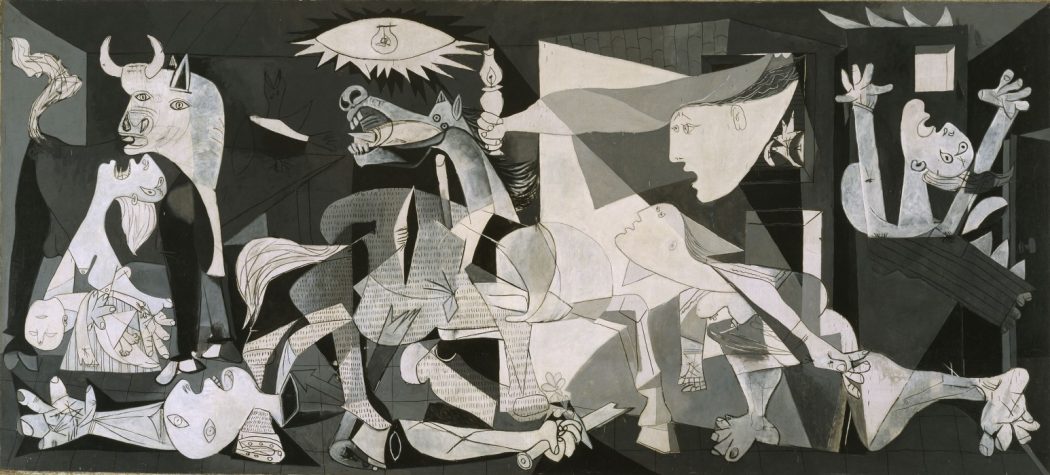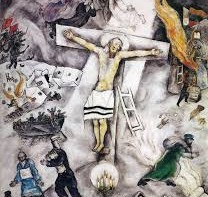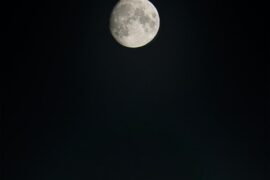[EDITOR’S NOTE: Giulia Privitelli continues our ‘Christian Doctrine and the Arts’ MLitt series with exploration of the engagement of the beholder to the ‘image of the imaged’ with consideration of Picasso’s view of ‘co-creators’ of his Guernica mural. For more information on this series, see the series introduction.]
It is well known that Pablo Picasso had several run-ins with his peers, with the authorities, the press, the police and the militia. One such story recounts Picasso in war-torn France, when a Gestapo officer suddenly barges into his Parisian apartment. He notices a postcard of the Guernica mural—itself a highly contested image[1] —then turns to the artist and asks: ‘Did you do that?’ ‘No’, Picasso quickly responds, ‘you did’.[2]
Although difficult to ascertain what Picasso might have intended with this comment, it might nonetheless be more fully understood with reference to a theology of icons. The Guernica emerges from a very specific socio-political context, and despite Picasso’s assertion that his concerns were primarily aesthetic in which his mission was ‘to paint and nothing else’,[3] the mural’s elusiveness and universal claims[4] represent a momentous shift in the engagement expected of the beholder; it is a revelatory image of the beholder’s involvement in his or her reality as ‘co-creator’,[5] much as it is with icons.
The legendary exchange between Picasso and the Gestapo officer, however arbitrary it may seem, hints at the reflective and self-reflective properties of images—and their reproduction—as they enter and partake in the drama of human history, suspended, as it were, between the unremitting tension of creation and destruction. This anecdote, furthermore, obliquely introduces the main threads that weave through the tangled history and conception of icons and idols in Christianity: authorship and identity, likeness and reality, and affective engagement, not to mention the apprehension and opposing viewpoints to the use of images. In other words, what is at stake is the notion that this kind of image—the icon—has and points to a life beyond itself; an icon in that it mediates otherness; an icon, then, as something which is not simply a representation in the strict sense, but a realisation, where the transition between the image and the imaged—the prototype—is immediate, mediating to the beholder a passage, indeed a conversion, as it also mediates a presence.[6]
the mural’s elusiveness and universal claims represent a momentous shift in the engagement expected of the beholder; it is a revelatory image of the beholder’s involvement in his or her reality as ‘co-creator’, much as it is with icons.
Before we explore this notion further, guided by the lamp of Picasso’s masterpiece, we must retrace our steps somewhat, for the defence of icons—in whatever form you may think of them—is a long and arduous one, shaped since the first centuries of Christianity by Scriptural hermeneutics, tradition and the theological development of Christian doctrine, all erected as strongholds on either side of the fray, by iconoclasts and iconodules alike. The antagonism towards religious imagery is primarily grounded in the Scriptures, particularly in the Decalogue and other passages in the Septuagint admonishing the creation and worship of graven images, that is, of the attempt to mediate God’s beauty and ineffability by translating it into finite means (Ex 20: 4). Or as we read in Schoenberg’s libretto of Moses und Aaron: ‘Begone, you idol, symbol of the impossibility of containing the Infinite in an image!’[7] Early patristic writers, such as Tertullian, Minucius Felix, Justin Martyr, Eusebius of Caesarea, and Epiphanius, among others,[8] all spoke of the dangers of images—a contention which is still expressed in the writings of modern thinkers such as Baudrillard with his notorious claim that ‘God himself was never anything but his own simulacrum’.[9] Indeed, in this view, any image of the divine infers a distortion and, therefore, according to Baudrillard’s classification of the image, an evil or diabolical representation.
Much of this, in fact, has to do with the comprehension of the nature of the icon, that is, the beholder’s engagement—a fundamental aspect in the distinction between idols and icons, even when the content is not explicitly Christological or religious. As it were, in Picasso’s Guernica, the ‘organ of beholding’—the eye—hangs unflinchingly above the theatre of human activity, which it equally reveals and hides from view.[10] In Sergius Bulgakov’s view, as with Jean-Luc Marion, an icon or any other image ‘can become an idol if one has an idolatrous attitude towards it’,[11] that is, when an image is understood in an incorrect and absolute way, that entraps one’s gaze (eido) or idea (oida) rather than orients and expands it. Michelangelo Buonarroti poignantly expressed this, in one of his poems no less, that his affectionate fantasy in his approach to art was ‘laden with error’, turning his art into an idol, enslaving him.[12] C S Lewis, in The Weight of Glory, recounts the dangers of mistaking the signifier for the signified that end up turning ‘into dumb idols, breaking the hearts of their worshippers’,[13] while Kierkegaard too notes the danger of religious images which, rather than serving as a via pulchritudinis towards God, may instead lead the beholder astray into illusion and disillusion, a similar hesitation shared by St Augustine.[14]

But let us go back for a moment to Scripture and to the decrees of the several Synods and Councils of the first millennium, for it is through these that a theological and doctrinal foundation concerning the meaning and use of the icon was fleshed out and, finally, validated. Georges Florovsky argues that the iconoclasts’ rejection of religious images was founded on ideas pertaining to the historic truth of the person of Christ.[15] ‘Anyone who makes an icon of Christ has failed to penetrate to the depths of the dogma of the inseparable union of the two natures of Christ’, decries Constantine V, the great supporter of the iconoclastic movement in the eighth century.[16] Indeed, the iconoclasts proclaim themselves as staunch defenders of the Christological dogma of the inseparable and hypostatic nature of the fully divine and fully human Christ, as established at the Council of Chalcedon. As it so happens, it is also in Christological doctrine that the iconodules found an ally, precisely through the event of the Incarnation—the Word made Flesh—an event that gave form and corporeality to the immaterial and invisible. Early defenders of icons, such as pseudo-Dionysius, Maximus the Confessor and, notably, John of Damascus, not only recognised and insisted on the importance of matter to guide the believer’s mind to spiritual realities, but that the theophany of God in Jesus Christ through the Holy Spirit, the entering of the infinite into the finite reality of matter, is a disclosure of the full reality of the Person of Jesus Christ and not a change in nature.[17] That is, that the invisible was rendered visible, as Paul Klee would famously later go on to say of art,[18] the uncontainable had measure, the formless had form, the ineffable could also be expressed. As Gregory of Nyssa puts it in Against Eunomius:
The first time, He took dust from the earth and formed man; this time, He took dust from the Virgin and did not merely form man but formed man around himself. The first time, the Logos made the flesh; this time, the Logos was made flesh, so that He might change our flesh to spirit, by being made partaker with us in flesh and blood.[19]
What we have, then, in this two-way movement is a new order of creation which was redeemed and, indeed, transformed and transcended—an order on which the Byzantine apologia of the making, content, use and meaning of icons rested: the Incarnation of Jesus Christ (which justifies the icon), his lived life as a continuous expression of Trinitarian relation (which informs the content), his Passion and Resurrection (which imbues the icon with a kerygmatic and mystagogical role). In The Meaning of Icons, Leonid Ouspensky takes up this position and argues that the Incarnation is a manifestation and expression of the descent of the creative and life-giving Spirit in the world of matter.[20] Indeed, mankind’s capacity for the expression of the ineffable divine reality was not possible prior to this event; neither word nor image could disclose who Christ the Son was[21]—the Eikon, the true Image and Likeness of God, after whom all of mankind is called to follow and become a part of. As Richard Viladesau and Ouspensky assert, for example, the icon is that which ‘mediates a presence’ and, therefore, does more than simply narrate a story or describe a figure.[22] Rather, it is an in-spired image that leads affectively to God, to the invisible yet ever-present prototype, thus proclaiming the same euangelion of the written Word.[23] Indeed, Paul Evdokimov speaks of the Holy Spirit as ‘the divine iconographer’.[24] Thus, in the Orthodox and Eastern Christian tradition, much attention is devoted to the creation, language and aesthetic consistency of the icon in such a way that ‘the very order…the very beauty of form in all that is visible, proclaim, however silently, both that the world was created and also that its Creator could be none other than God whose greatness and beauty are both ineffable and invisible’, as St Augustine writes in De Civitate Dei.[25]
the icon is liberated from content and, indeed, from its author. It does not permit the gaze to settle as it signals to that which is beyond itself.
In their affordance for ‘rendering present’ the Spirit of God, icons thus carry a quasi-sacramental, pneumatological value, and play a central role especially in Eastern Christian religious life, ritual and worship. As Geoffrey Wainwright outlines:
It is by the Holy Spirit that the painter works; it is by the Holy Spirit that the icon is consecrated for liturgical use; it is by the Holy Spirit that the worshipper approaches the icon in contemplation. The Holy Spirit dwelt in Christ and in his saints who are depicted by the icons; Christ and his saints now make their presence known to the assembly in the Holy Spirit through the medium of the icons.[26]
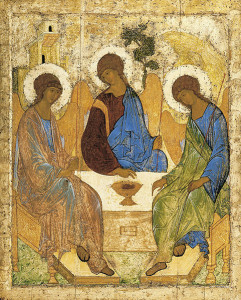
Indeed, as both Bulgakov and Ouspensky note, the believers’ creation and veneration of icons is a form of participation in the divine reality; the icons are a prayer—an immediate portal and access to dialogue with the divine. The reversed perspective, as we see in Andrei Rublev’s icon of the Holy Trinity, with the empty ‘fourth seat’, suggests an exchange with and invitation to the beholder, as is the preference for a style and composition that encourages stillness, contemplation and timelessness, as well as a heightened sense of presence. The point is that the beholder is the one who is already seen, and is invited to see more. Bissera Pentcheva notes, for example, the centrality of the icon in producing a sacred space for affecting a relation between mankind’s physicality and God.[27] As God ‘breathes’ on the ‘image’—Adam—so too does the iconographer breathe on the icon as it is created, and so too does the worshipper who kisses and prays through the icon (ad-os-oris, adoratis), affectively breathing life onto it. As Martin Buber writes in I and Thou: ‘…the relation in which I stand to it is real, for it affects me, as I affect it’.[28]
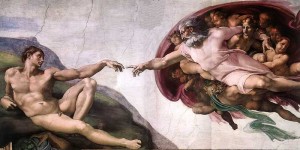
The invitation of the icon, then, involves a transformation, a way to relate to God through mimesis and the acquisition of an expanded vision. Curiously, as Bulgakov points out, the belief that a deity is relatable and may, indeed, be portrayed by human hands, even if inadequately, can be traced to a pagan tradition. But in pagan tradition, gods were fashioned on the idealised image of mankind.[29] They represented the splendour of visible forms, a natural but unrealistic eidolon. As Marion explains, in fact, mankind is the original model of the idol since the concept originates from humans and not from God.[30] However, as we read in 2 Cor 3:18, this movement is reversed in the Christian understanding of the icon: ‘…with face unveiled and revealed, serving as an optical mirror to reflect the glory of the Lord, we are transformed in and according to his icon’.[31] It comes as no surprise, then, that Picasso should first turn to classical tradition and myth to serve as the basis for his great masterpiece. But here, the idealised image is likewise completely turned on its head; we are confronted by the image of the defeat of mankind, by the gaping wounds of the last two centuries of Spanish history—wounds that may be traced to the very prototype of Christ’s wounded body, at once the image of abject mortality and suffering and, at another, the glorified image of divine splendour. This is, perhaps, what Basil of Caesarea intended by his claim that ‘man is a creature, but he is commanded to become God’.[32]
This dialectic between the divine made human (descending) and the human made divine (ascending), is also precisely expressed through the choice of traditional iconographic content which includes, aside from those related to Christ, icons of the Virgin and saints of the Church, who partake as ‘one body’ in the glorified, Resurrected body of Christ. But we can take this even further, beyond the strict parameters of the Orthodox icon, as we are here speaking on terms which transcend content and mere matter. In Marion’s view of the icon, for example, the icon is liberated from content and, indeed, from its author. It does not permit the gaze to settle as it signals to that which is beyond itself.[33] The inability to make an idol of any one part of the image (or its maker), then, reorients and expands the gaze, ‘giving rise to an infinite gaze’.[34] Thus, for example, the different viewpoints of a Cubist work—say, Picasso’s Guernica—come together in the eyes and mind of the viewer, where the personal, expanded, meaning of the work is disclosed. Or to put it differently, quoting Martin Buber: ‘The Thou meets me through grace—it is not found by seeking…It comes, and comes to bring you out’ and ‘helps you to glimpse eternity’.[35] It is in this way that the Christian approach to icons—as mediator of a passage and presence—becomes an active participation in the theosis of the human being, in the union of man with God through the recovery of likeness and meaning, whereby the beholder rediscovers himself or herself as an image, and reflection, of the ‘light, activity and goodness’ of the divine Creator.[36]
believers’ creation and veneration of icons is a form of participation in the divine reality; the icons are a prayer—an immediate portal and access to dialogue with the divine.
To conclude, then, the invitation of the icon is that the ‘It’—the object—having participated in time and space, becomes ‘Thou’, which transcends both time and space. Every icon or religious image seen in this way, as St John of Damascus would argue, manifests and indicates its secret,[37] its mystagogical and ontological essence. ‘Did you do that?’ the Gestapo officer asked. ‘No, you did’. Might not this exchange also be had over the arguably most defining image and icon of Christianity, the Crucified Christ, the act of renewed creation? And yet, it is precisely the cross, prefigured in the image of the brazen serpent, on which believers must fix their eyes for their salvation.[38] If the cross is the doing of mankind—that is, the idol of mankind’s sinfulness and ingratitude—as the seat of the indestructible Eikon, Jesus Christ, it is transformed into a new creation. Thus, through the Christological doctrine of the Incarnation, Passion and Resurrection which appeals to the believer’s conversion and participation in this new creation, art itself is transformed and imbued with an unprecedented role: here is the icon, redeemed and rescued from idolatry, that discloses its beholder as ‘created co-creator’, much like the Gestapo officer, in fact, beholding the image of Picasso’s Guernica.
Image Credits
Pablo Picasso, ‘Guernica’, 1937. Oil on canvas, 349 cm × 776 cm. Photo by Joaquín Cortés/Román Lores. Museo Nacional Centro de Arte Reina Sofia © Sucesión Pablo Picasso. VEGAP. Madrid, 2012.
Andrei Rublev, ‘The Trinity’ (detail), 1425-1427. https://commons.wikimedia.org/wiki/File:Angelsatmamre-trinity-rublev-1410.jpg.
Michelangelo, ‘The Creation of Adam’, c. 1512, 280 cm × 570 cm. https://commons.wikimedia.org/wiki/File:The_Creation_of_Adam.jpg
Notes
[1] When the Guernica was first displayed at the World’s Fair in Paris, in 1937, it was received with mixed reviews. One British art historian, Anthony Blunt, in a later exhibition in London, for example, referred to it as a ‘fraud’. See Anthony Blunt, ‘Picasso Unfrocked’, The Spectator, October 8, 1937, 584. Moreover, in 1974, the year following Picasso’s death, the Guernica was vandalised in a pseudo-iconoclastic twist, somewhat recalling the offensive stance taken up against the use of icons. See, for example, Michael T Kaufman, ‘Guernica’ Survives a Spray-Paint Attack by Vandal’, The New York Times, March 1, 1974, 1. This incident, however, further attests to the mural’s power to challenge the viewer and has not, since its conception, ceased to garner the attention of admirers and critics alike. Indeed, it is arguably one of the most commented and cited works of the twentieth century and has generated innumerable interpretations—an image which, indeed, seems to resist being bogged down to one meaning, to one way of seeing.
[2] Simon Schama, The Power of Art (London: BBC Books; Penguin Random House, 2006), 354.
[3] Cited in Schama, op. cit., 355.
[4] Ad Reinhardt, in an article titled ‘How to Look at a Mural,’ expressed the transcendental qualities of the Guernica, describing it as ‘a design that diagrams our whole present dark age,’ and not some ‘simple poster or banal political cartoon which you can easily understand (and forget) in a few minutes.’
[5] Philip Hefner, ‘The Evolution of the Created Co-Creator’, in Cosmos as Creation: Theology and Science in Consonance, ed. T Peters (Nashville: Abingdon, 1989), 211.
[6] Cornelia Tsakiridou, Icons in Time, Persons in Eternity. Orthodox Theology and the Aesthetics of the Christian Image (Farnham: Ashgate, 2013), 213.
[7] Cited in Richard Viladesau, Theological Aesthetics: God in Imagination, Beauty and Art (New York: Oxford University Press, 1999), 46.
[8] See Cyril Mango, The Art of the Byzantine Empire 312–1453 (Toronto: University of Toronto Press, 1986), 16–18, 41-44.
[9] Jean Baudrillard, Simulacra and Simulation, trans. S F Glaser (Michigan: The University of Michigan Press, 1994), 4.
[10] Schama, The Power of Art, 383.
[11] Sergius Bulgakov, Icons and the Name of God, trans. B Jakim (Grand Rapids: William B. Eerdmans Publishing Company, 2012), 91.
[12] ‘So now I recognise how laden with error / was the affectionate fantasy / that made art an idol and sovereign to me’, Sonnet no. 285, v.5-7, from James M Saslow, ed., trans., The Poetry of Michelangelo. An Annotated Translation (New Haven: Yale University Press, 1991), 476–477.
[13] C S Lewis, The Weight of Glory (New York: HarperCollins, 1976), 31.
[14] Christopher B Barnett, ‘Painting with Words. Kierkegaard and the Aesthetics of the Icon’, in Kierkegaard, Literature, and the Arts, ed. E Ziolkowski (Evanston: Northwestern University Press, 2018), 176–191.
[15] Georges Florovsky, Collected Works, vol. 2 (Belmont: Nordland, 1972), 115.
[16] Nicephorus, Refutation, 1.42 (PG 100, 240); cited in Jaroslav Pelikan, Imago Dei: The Byzantine Apologia for Icons (Princeton and Oxford: Princeton University Press, 1990), 74.
[17] Pseudo-Dionysius the Areopagite, ‘On the Heavenly Hierarchy’, in The Works of Dionysius the Areopagite. Part II, trans. J Parker (London and Oxford: James Parker and Co., 1899), 1–66, esp. 4–7; George Berthold, Maximus Confessor: Selected Writings (New Jersey: Paulist Press, 1985), 189.
[18] Paul Klee, ‘Creative Credo’, in Paul Klee Notebooks. Volume 1. The Thinking Eye, ed. Jürg Spiller, trans. Ralph Manheim (London: Lund Humphries, 1961), 76.
[19] Gregory of Nyssa, Against Eunomius, 4.3 (PG 45, 637); cited in Pelikan, Imago Dei, 71–72.
[20] Leonid Ouspensky, ‘The Meaning and Language of Icons’, in The Meaning of Icons, ed. U Graf-Verlag (Boston: Boston Book and Art Shop, 1952), 29–50.
[21] Cf., Mt 16: 17.
[22] In relation to the crucifix as ‘iconic’ for reasons that will become apparent later in the paper, see Richard Viladesau, The Beauty of the Cross (Oxford: Oxford University Press, 2006), 68. Although the distinction might have been oversimplified, Erwin Panofsky uses the term imago to refer to a religious image that transcends narrative and which is, therefore, timeless. Erwin Panofsky, ‘Imago Pietatis’ e altri scritti del periodo amburghese (1921–1933), trans. G. Montinari (Torino: Il Segnalibro, 1999).
[23] ‘the icon contains and proclaims the same truth as the Gospel’. Leonid Ouspensky, Theology of the Icon, trans. A. Gythiel, vol. 1(New York: St Vladimir Seminary Press, 1992), 138.
[24] Paul Evdokimov, L’Art de Vicone: Theologie de la beaute (Paris: Desclee de Brouwer, 1972), 13.
[25] Augustine of Hippo, Writings of Saint Augustine, trans. G G Walsh and M G Monahan, vol. 7 (Washington: The Catholic University of America Press, 1952), 191.
[26] Geoffrey Wainwright, ‘The Holy Spirit’, in The Cambridge Companion to Christian Doctrine, ed. C E Gunton (Cambridge: Cambridge University Press, 1997), 291.
[27] Bissera V Pentcheva, ‘The Performative Icon’, The Art Bulletin 88, no. 4 (Dec 2006): 631–655, here at 640.
[28] Martin Buber, I and Thou, trans. R. G. Smith (Edinburgh: T&T Clark, 1937), 10.
[29] Bulgakov, Icons and the Name of God, 3–5.
[30] Jean-Luc Marion, God Without Being, trans. T A Carlson (Chicago and London: The University of Chicago Press, 1995), 16.
[31] See Aidan Nichols, ‘Christ the Image of God’, in The Art of God Incarnate: Theology and Image in the Christian Tradition (Oregon: Wipf and Stock, 2016), 30–49, esp. 44–46.
[32] John Henry Newman, ‘The Church of the Fathers’, in Historical Sketches, vol. 2 (London: Longmans, Green, and Co., 1906), 10.
[33] Marion, God Without Being, 18–19.
[34] Ibid., 18.
[35] Buber, I and Thou, 11.
[36] Nichols, ‘Christ the Image of God’, 32.
[37] John of Damascus, On Holy Images, trans. M. H. Allies (London: Thomas Baker, 1898), 93.
[38] Cf., Numbers: 21: 6–9; John 3: 14–15.

